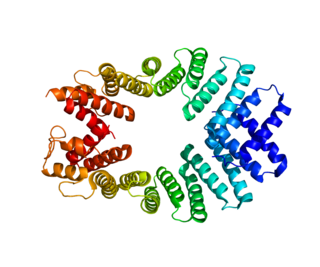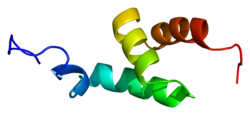
E3 ubiquitin-protein ligase RNF216 is an enzyme that in humans is encoded by the RNF216 gene.

Kinesin light chain 2 is a protein that in humans is encoded by the KLC2 gene.

Ubiquitin-like modifier-activating enzyme 6 is a protein that in humans is encoded by the UBA6 gene.

N-acetyltransferase 10 is an enzyme that in humans is encoded by the NAT10 gene.

Ubiquitin carboxyl-terminal hydrolase 1 is an enzyme that in humans is encoded by the USP1 gene.

Ubiquitin specific processing protease 37 is an enzyme that in humans, is encoded by the USP37 gene.

Histone deacetylase complex subunit SAP130 is an enzyme that in humans is encoded by the SAP130 gene.

Ubiquitin-like modifier-activating enzyme 5 is a protein that in humans is encoded by the UBA5 gene.

Shugoshin 2(Shugoshin-2), also known as Shugoshin-like 2, is a protein which in humans is encoded by the SGO2 gene.

39S ribosomal protein L15, mitochondrial is a protein that in humans is encoded by the MRPL15 gene.

Ubiquitin-like protein 3 is a protein that in humans is encoded by the UBL3 gene.

Mitochondrial Rho GTPase 1 (MIRO1) is an enzyme that in humans is encoded by the RHOT1 gene on chromosome 17. As a Miro protein isoform, the protein facilitates mitochondrial transport by attaching the mitochondria to the motor/adaptor complex. Through its key role in mitochondrial transport, RHOT1 is involved in mitochondrial homeostasis and apoptosis, as well as Parkinson’s disease (PD) and cancer.

Ubiquitin carboxyl-terminal hydrolase 44 is an enzyme that in humans is encoded by the USP44 gene.

CD320 is a human gene.

Spartan (SPRTN) is a protein that in humans is encoded by the SPRTN gene. It is involved in DNA repair. Ruijs-Aalfs syndrome is an autosomal recessive genetic disorder. Characteristics of this disorder are features of premature aging, chromosome instability and development of hepatocellular carcinoma. Ruijs-Aalfs syndrome arises as a result of mutations in the SPRTN gene that encodes a metalloproteinase employed in the repair of protein-linked DNA breaks.

E3 ubiquitin-protein ligase ZNRF1 is an enzyme that in humans is encoded by the ZNRF1 gene.

ATP synthase mitochondrial F1 complex assembly factor 2 is an enzyme that in humans is encoded by the ATPAF2 gene.

Pseudouridylate synthase 7 homolog-like protein is an enzyme that in humans is encoded by the PUS7L gene.

Kelch-like protein 18 is a protein that in humans is encoded by the KLHL18 gene.

Ubiquinone biosynthesis protein COQ9, mitochondrial, also known as coenzyme Q9 homolog (COQ9), is a protein that in humans is encoded by the COQ9 gene.





















